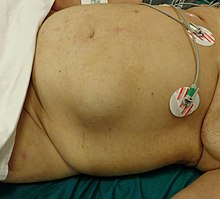Spigelian hernia
A Spigelian is the type of
It is the protuberance of
| Spigelian hernia | |
|---|---|
| Other names | Lateral ventral hernia |
 Signs and symptomsIndividuals typically present with either intermittent pain, a lump or mass, all which are classic signs of a bowel obstruction.[2] The patient may have a protuberance when standing in an upright position although discomfort can sometimes be confused by its anatomical region for a peptic ulceration.[3] The bulge may be painful when the patient stretches but then goes away when they are lying down in a resting position.[4] However, a number of patients present with no obvious symptoms but vague tenderness along the area in which the Spigelian fascia is located.[5] Diagnosisanteriorly and medially to the inferior epigastric artery during Valsalva maneuver.[7] The diagnosis of a Spigelian hernia is traditionally difficult if only given a history and physical examination.[8] People who are good candidates for elective Spigelian hernia surgery, after receiving an initial diagnostic consultation by a licensed medical professional, will be advised to see a physician to schedule surgery.
TreatmentThe Spigelian hernia can be repaired by either an strangulation.[9] Surgery is straightforward, with only larger defects requiring a mesh prosthesis. In contrast to the laparoscopic intraperitoneal onlay mesh plan of action there is a significant higher risk associated with complications and recurrence rates during the period following a surgical operation.[10] A Spigelian hernia becomes immediately operative once the risk of incarceration is confirmed.[citation needed] Today, a Spigelian hernia can be repaired by doing robotic laparoscopy and most patients are discharged on the same day. This novel, uncomplicated approach to small Spigelian hernias combines the benefits of laparoscopic localization, reduction, and closure without the morbidity and cost associated with foreign material.[11] Mesh-free laparoscopic suture repair is an uncomplicated approach to small Spigelian hernias combined with the benefits of a closure without the anguish and cost associated with foreign material.[6][12]
EponymAdriaan van den Spiegel was an anatomist at the University of Padua during the 17th century. He became a professor of surgery in 1619 and was the first to describe this rare hernia in 1627.[13] The history of the Spigelian hernia was acknowledged in 1645, twenty years after Spiegel's death. In 1764, almost a century later, the Flemish anatomist, Josef Klinkosch, was acknowledged for recognizing and describing a hernia located in the Spigelian fascia, and coined the term Spigelian hernia.[14] Raveenthiran syndromeRaveenthiran described a new syndrome in which Spigelian hernia and References
External links
Wikimedia Commons has media related to Spigelian hernia.
| |

